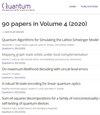非阿贝尔晶格规范理论的噪声量子模拟对称性验证
IF 5.1
2区 物理与天体物理
Q1 PHYSICS, MULTIDISCIPLINARY
引用次数: 0
摘要
非阿贝尔规范理论奠定了我们对现代物理学基本力的理解。在快速发展的量子模拟领域中,在量子硬件上模拟它们是一个突出的挑战。一个关键的先决条件是保护局部规范对称性,防止错误,如果不加以检查,将导致非物理结果。虽然已经为阿贝尔群开发了一个专门用于识别、减轻和最终纠正此类错误的广泛工具包,但非交换对称算子使非阿贝尔理论中类似方案的实现复杂化。在这里,我们讨论了两种通过对称验证来减小误差的技术,这两种技术是为在噪声量子比特硬件中实现的非阿贝尔晶格规范理论而定制的:基于无主动反馈的中路测量的动态后选择(DPS)和结合了目标可观测值和规范变换之间相关性测量的后处理对称验证(PSV)。我们在2+1维的离散非阿贝尔群$D_3$中说明了这两种方法,解释了它们对当前NISQ器件的实用性,即使存在快速波动噪声。我们的研究结果为非阿贝尔规范理论的鲁棒量子模拟、误差缓解技术的进一步发展以及量子平台中基于测量的控制方法开辟了新的途径。本文章由计算机程序翻译,如有差异,请以英文原文为准。
Symmetry verification for noisy quantum simulations of non-Abelian lattice gauge theories
Non-Abelian gauge theories underlie our understanding of fundamental forces of modern physics. Simulating them on quantum hardware is an outstanding challenge in the rapidly evolving field of quantum simulation. A key prerequisite is the protection of local gauge symmetries against errors that, if unchecked, would lead to unphysical results. While an extensive toolkit devoted to identifying, mitigating, and ultimately correcting such errors has been developed for Abelian groups, non-commuting symmetry operators complicate the implementation of similar schemes in non-Abelian theories. Here, we discuss two techniques for error mitigation through symmetry verification, tailored for non-Abelian lattice gauge theories implemented in noisy qudit hardware: dynamical post-selection (DPS), based on mid-circuit measurements without active feedback, and post-processed symmetry verification (PSV), which combines measurements of correlations between target observables and gauge transformations. We illustrate both approaches for the discrete non-Abelian group $D_3$ in 2+1 dimensions, explaining their usefulness for current NISQ devices even in the presence of fast fluctuating noise. Our results open new avenues for robust quantum simulation of non-Abelian gauge theories, for further development of error-mitigation techniques, and for measurement-based control methods in qudit platforms.
求助全文
通过发布文献求助,成功后即可免费获取论文全文。
去求助
来源期刊

Quantum
Physics and Astronomy-Physics and Astronomy (miscellaneous)
CiteScore
9.20
自引率
10.90%
发文量
241
审稿时长
16 weeks
期刊介绍:
Quantum is an open-access peer-reviewed journal for quantum science and related fields. Quantum is non-profit and community-run: an effort by researchers and for researchers to make science more open and publishing more transparent and efficient.
 求助内容:
求助内容: 应助结果提醒方式:
应助结果提醒方式:


